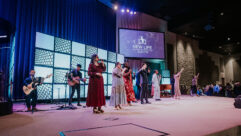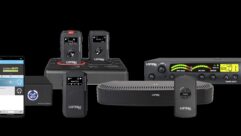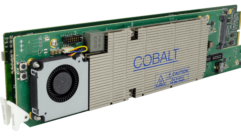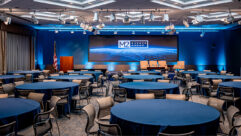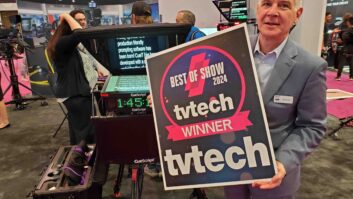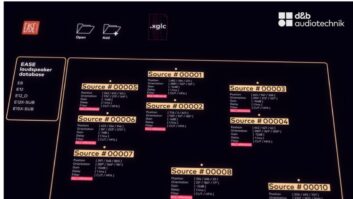A New Jersey Landmark Is Reborn
Jul 1, 2002 12:00 PM,
By John Chester
Historic buildings offer unique challenges, especially when it comes to renovating sound systems. Such was the case in the design and installation of the new audio system at Atlantic City’s 73-year-old Historic Boardwalk Hall, the city’s original convention center. Designer/installer Philadelphia Sound Productions Inc. and audio consulting firm Pelton, Marsh and Kinsella (a division of Dallas-based Carter & Burgess Inc.) took on the task, using the JBL HLA-based sound system to bring modern sound to the venue.
The original Atlantic City Convention Hall has long been a seaside landmark. Despite the endurance of its grand façade, advancing technology has made the 1929 structure less relevant as an entertainment venue. A new, larger Atlantic City Convention Center opened in 1997 to meet the needs of the growing city, leaving the future of the older building in doubt. The new Convention Center offers 500,000 square feet of exhibition space, with 45 meeting rooms on a 31-acre site.
The New Jersey Sports and Exposition Authority could not turn its back on the old landmark, though. Rechristened Historic Boardwalk Hall, the old building was soon slated for a major renovation, including additional seating, refurbishment of the venue’s multimillion dollar organ and the addition of an ice surface for the ECHL’s Boardwalk Bullies’ inaugural season. An up-to-date sound system would top off the renovations. Performers as diverse as Neil Diamond, Britney Spears, Luciano Pavarotti and WWE’s (formerly the WWF) “The Rock” have entertained crowds at the venue recently.
Boardwalk Hall has a long and storied past. Dedicated in 1929 as the Atlantic City Convention Hall, the building boasted the largest clear-span space in the world, a whopping 141,360 square feet. Rising 137 feet above the convention center floor is a barrel vault ceiling. The unique curvature of the ceiling was a technological advance for its time, allowing novel application of reflected lighting to brighten the hall. Originally conceived as an exhibition hall and convention space, the facility immediately found itself hosting a wide array of events. The original plan for a commercial exhibition space gave way to a broader vision of a civic hall truly for the residents and guests of Atlantic City. From epic boxing matches, featuring the likes of George Foreman and Roberto Duran, to national political conventions, the hall has long stood near the center of American life. In 1940, the hall became the permanent home of the Miss America Pageant. As the planners declared in stone, the hall became New Jersey’s center for “Festivities, Music, Pageantry, Drama, Athletics, Education, Science, Conventions, Art and Industry.”
A FRESH COAT OF PAINT
with the goal of turning the old center into a modern venue for performances and sporting events, as well as to provide a fitting showcase for the Miss America pageant, preparations for the renovation began. According to David Stearns of Pelton, Marsh and Kinsella, construction was scheduled in phases over a three-year period, from 1998 to the fall of 2001. Although the plans called for extensive improvements, the design team wanted to preserve and enhance important aspects of the landmark’s character. The original barrel-vaulted ceiling has been restored to provide improved acoustics and lighting effects, for example.
The historic ceiling needed to be upgraded to eliminate asbestos fireproofing on the trusses. “As a result, we needed to make significant improvements to the acoustic character of the space,” Stearns said. He estimates that the RT-60 of the original hall was between seven and eight seconds. “We needed to reduce that to the 1-2 second range,” Stearns said. “It is a difficult room, given the curved ceiling [and the] perforated metal panels on the ceiling and end walls that are used for creative lighting effects.” A computer-controlled network of color-ized luminaries is designed to up-light the restored ceiling with a full spectrum of colors. “We specified a number of fiberglass absorbers behind the metal panels that would deaden the reverb,” Stearns said. “We also paid a lot of attention to the location of the main loudspeaker array. Originally, this was going to comprise four cabinets located on each side of the scoreboard, plus a downfill.”
In the past several years, various design concepts had been proposed for Historic Boardwalk Hall. One idea was to place the amplifiers and loudspeaker cabinets together on the flown P.A. system (to reduce speaker-cable runs) and adding a self-contained air-conditioning unit to ensure optimum operating conditions for the power amps. The strategy was for the entire sound system to be self-contained and capable of being removed when it was not required. For several reasons, including cost and complexity, that design was never implemented. Originally the sound system renovation was to be completed by early fall of 2001 with official unveiling for the 2002 Boardwalk Bullies season, but that was delayed for seven months.
360-DEGREE COVERAGE
philadelphia sound productions partnered with JBL Professional, the Harman Professional Projects Group and Palmieri Electric Inc. to provide a workable solution. A new sound system, retaining the intent of the original specifications, was custom designed for the building. The system is comprised of various JBL Professional Horn-Loaded Array Series loudspeaker cabinets and other speakers, Crown power amplifiers and BSS Soundweb digital controllers. Walter Mosetter of PSP designed the plan of action. “Because our rental division has used HLA in this venue before, HLA was a natural choice,” Mosetter said. “For flexibility, the permanent speaker array needed to be portable so it could be lowered and raised for different events. We advised that a centralized, climate-controlled amplifier room made more sense than colocating them with the speaker cabinets, despite the longer cable runs. We also specified Crown power amplifiers under IQ remote control to monitor the current loading on a local PC. That way we can diagnose problems remotely and only lower the system when necessary to fix a rare problem.” IQ offers the advantage of both controlling the system amplifiers and monitoring the speakers remotely.
To provide 360-degree coverage, the new JBL HLA flown array of 21 speakers is divided into four zones, with three cabinets for the upper and lower quadrants of each of the south-, east- and west-facing directions. A single array of three cabinets was used for north-facing directions, which, because of the Hall’s orientation, requires less sound level than other areas.
JBL Professional’s HLA-4895 is a high-power, three-way full-bandwidth speaker system. To reduce weight and simplify rigging, the cabinet features a trapezoidal Space Frame constructed of welded aluminum tubing. It weighs 230 pounds. When flying HLA cabinets, the Space Frame distributes the weight throughout the entire cabinet rather than concentrating stress at the mounting points. According to JBL, replacing wooden boxes with an aluminum Space Frame helps reduce weight and provides an ergonomic platform for a user-adjustable waveguide. Built into each cabinet is an intrinsic rigging system with channels that accept the hardware used to fly the HLA Series. BSS Soundweb DSP is used for crossover and internal time alignment of each cabinet.
Differential Drive cone transducers used in the HLA-4895 offer very low weight and high output with low power compression. In addition to being one-third the weight of conventional transducers, they are also more efficient, allowing a system to use fewer amplifiers to deliver the same output levels. The HLA-4895 includes a multiband waveguide assembly that tilts within the Space Frame, thus facilitating quick setup to achieve precise coverage without tilting the cabinets. Optimized Aperture Design provides wideband, controlled coverage with very low distortion.
The upper and lower primary arrays are augmented by four dedicated downfill speakers, custom designed by PSP, and two JBL Sound Power SP128S subwoofers that house dual model 2242H 18-inch LF drivers. The downfills house a model 2010 10-inch LF/MF driver, plus a model 2447 two-inch transducer on a DDS horn in a custom cabinet.
Mosetter cites the invaluable assistance of his staff and partners, including Joe Knecht from Palmieri Electric and job site foreman Joe Vanderslice. “We spent 10 days measuring and carefully fabricating the 900-foot cable runs and audio snakes while awaiting arrival of the hardware,” Mosetter said. “We laid out the system on the floor, and we were able to rig the array and cabling in less than a day. The architects — John Sassmann from Ewing, Cole, Cherry and Brott Associates — supplied the rigging points for the custom bumpers for HLA that connected to the hanging points using buckles and shackles. One of the more difficult tasks was devising a way to prevent the speaker cabling that extends 180 feet from the ceiling from fouling the array as it rises and descends. We used a combination of No. 8 and No. 10-gauge cable and fabricated a platform to control the cable drop.”
A series of 14 JBL Custom Shop horizontal two-way cabinets, mounted on the upper lighting grid, provide additional delay coverage for the upper regions of the auditorium, as well as a distributed sound system in key public areas and meeting. The speaker houses a 2206H LF transducer and a 2447J 1.5-inch exit compression driver on a 2332 biradial horn that provides 90-by-50-degree coverage. The equipment racks were built and tested at PSP’s shop in University City and trucked to the job site ready to install. Eddie Keys of Rapco International provided all of the custom plates and panels and specialty cables in record time.
SIGNAL PROCESSING AND ROUTING
output from the facility’s main Soundcraft K1 mixing console is processed and routed throughout the digital audio bus. All signal processing, routing, distribution, equalization and delay is handled by one BSS Soundweb 9088ii, four Soundweb 9008ii networked DSP devices and one 9010 Jellyfish remote controller. The units are distributed between the audio control room and the amplifier room. Each Soundweb controller handles input routing from input sources routing to multiple eight-output bus matrices. Although each of the 21 HLA loudspeakers and four downfill cabinets receive individually routed LF, MF and HF feeds, both subwoofers receive a common feed. The system has the ability to route independently throughout the building. “The room does not need a lot of low-end reinforcement,” Mosetter said, “but for events like the WWE bouts, we have to handle high-energy mixes that need a low-end capability.”
Crown Model MA5002 amplifiers, using six channels of amplifiers per cluster, power the system. “Because these amps can handle two loads, we were able to hang three cabinets on each power-amp channel,” Mosetter said. “For the rest of the event floors, concourses and public areas, we used Crown CT 810s under IQ control.” A rackmounted Pentium IV computer running Windows XP Professional with dual flat screen monitors handles computer control and monitoring of the system. BSS Soundweb and Crown IQ 5.02 are open and running simultaneously on each screen. Operation of the system is password protected.
Chris Hartnett has been the convention center complex’s systems manager since 1997 and has served with the Hall’s sound department since 1975, becoming the department head in 1982. Although the original system was used only for P.A. purposes, the new system has proved to be a vast improvement. “[It’s] light years ahead of the [last] system,” Hartnett said. The vaulted ceiling forms a natural parabolic reflector, with lots of sound reflections. The new system is designed to provide plenty of sound energy, but with controlled coverage in the 13,500-seat audience area. Even lay people notice the difference in sound quality. “The original specification would have required double the budget we had available, so we needed to rethink the concept,” Hartnett said. “What we have now, with its digital control capabilities, is more flexible than other solutions. We had rented JBL HLA systems for two wrestling events and had a good experience.”
A 24-channel Soundcraft analog mixing console and BSS Jellyfish are located on a landing with the Light and Sound department. It looks out onto the south end of the arena at midlevel. The house’s sound engineer uses a set of local monitor speakers for cues but mixes with the house cluster speakers to represent what the audience hears. The engineer has total local control of the system through the console matrix and aux outputs to shape the exact sound needed for each type of event. Road shows can patch in to the system and use just the delay system or portions of the cluster.
“It is an excellent mix position,” said Hartnett. “It works well. We don’t need too many input channels [on the console]. Main left and right outputs pass to the BSS Soundweb controllers, though we usually mix the shows in mono. Having used the Soundweb controller units to balance the system, I walked the floor and listened in every area. I was impressed by how even the coverage was. We use only two subwoofers because the low end rolls around the auditorium, but the combination works well for the high-energy events held here.”
Hartnett said Mosetter and PSP, which supplied audio systems to several local venues, including the new Atlantic City Convention Center and Wildwoods Convention Center, provided great attention to detail. “We have full and detailed documentation on the installation, and we know where every wire has been laid,” Hartnett said.
The sound system of HLA speakers with custom subwoofers and fill speakers was so effective that even the designer’s hopes were surpassed. “After all of our hard work it was gratifying to discover that the overall performance of the JBL HLA array exceeded even our expectations,” Mosetter said. The success of the installation has been unequivocal. As for Miss America, she will now have a sound system equal to her fame.
John Chester, former managing editor of the Leisure Trends Group, is a freelance writer and marketing research and communication consultant based in Wondervu, Colorado. He can be reached at [email protected]. Mel Lambert also contributed to this article.
For More Information
BSS
bss.co.uk
Ž 204
Crown
crownaudio.com
Ž 205
Ewing, Cole, Cherry and Brott Associates
ewingcole.com
Ž 206
Harman Professional Projects Group
harman.com
Ž 207
JBL Professional
jblpro.com
Ž 208
Pelton, Marsh and Kinsella
Pmkconsultants.com
Philadelphia Sound Productions Inc.
Philasound.com
Rapco International
rapco.com
Ž 209
Soundcraft
Soundcraft.com210
Ž 210
Ž=Circle this number on Reader Service Card for more information.



